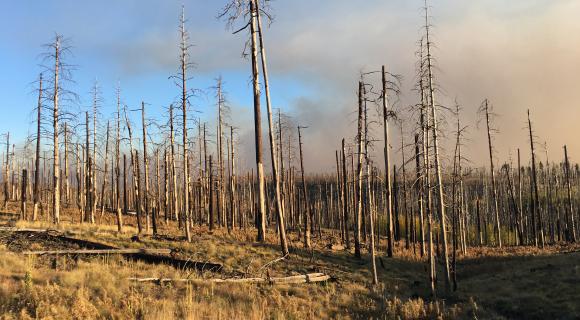- Written by Rachel Frost, Montana State University; Revised by Anne Gondor and Austin Rutherford, University of ArizonaBody
Cultural methods involve manipulating the timing, intensity, or duration of a land use or management action to achieve a desired vegetation composition and/or structure. Cultural control is most often employed to manage invasive weeds or deter undesirable species in traditional agriculture fields but also on rangeland landscapes. Targeted grazing, prescribed fire, and seeding desirable vegetation are the most common rangeland cultural methods (also see Related Resources below).
Cultural practices are often incorporated into an integrated approach in consideration with biological, cultural, and mechanical methods to maximize brush management goals. Selecting the appropriate cultural technique to meet your goal(s) can depend heavily on cost of implementation, but managers should also consider regional-, local-, and site-level soil, elevation, and weather (or climate) conditions to maximize efficacy in both short- and long-term time frames.
A simplified example of a cultural method application includes seeding a desirable, competitive herbaceous species that can capture soil and water resources that aids in preventing resource capture by competing undesirable brush species following a mechanical practice. Considerations on the site suitability, species selection, and timing with precipitation (or the rainy season) for germination and establishment will be critical for seeding potential success.
Related Resources
Videos
Cultivating Healthy Plants-Revegetation Strategies for Rangelands
Russell Wilhelm, Seed Program Manager for the of the Nevada Department of Agriculture, discusses strategies for rangeland restoration that will help promote rangeland health and longevity, and assist to suppress wildfire intensity and decrease frequency. This recording also discusses the use of locally adapted, genetically appropriate, seed.
Healthy Rangelands: Control Gullies, Control Brush, Save Grasslands!
Old water control structures create drastic impacts on grasslands. Mary Nichols researches these structures and their roles in the formation of gullies in rangelands which convert them into predominately hosting brush.
Tools
- This tool is designed to assist land managers with the rangeland restoration and/or rehabilitation planning process. The tool assembles information ab…
- University of Arizona Cooperative Extension's easy to use platform to investigate potential species based on site characteristics and management…
Featured Resources From the Database
- Journal Issue/Article
A revegetation technique study was established in a disturbed sagebrush-juniper community in northwestern Colorado in the fall of 1976. The purpose of the study was to identify…
- Journal Issue/Article
The most successful conversions of sagebrush to crested wheatgrass, in areas of the Western United States that receive an average of 8 to 14 inches of precipitation annually,…
- Journal Issue/Article
Cultural Methods and Their Relation to Establishment of Native and Exotic Grasses in Range Seedlings
This material was digitized as part of a cooperative project between the Society for Range Management and the University of Arizona Libraries. The Journal of Range Management…
Additional Links
Further Reading
- University of California Cooperative Extension. Cultural Control Strategies.
